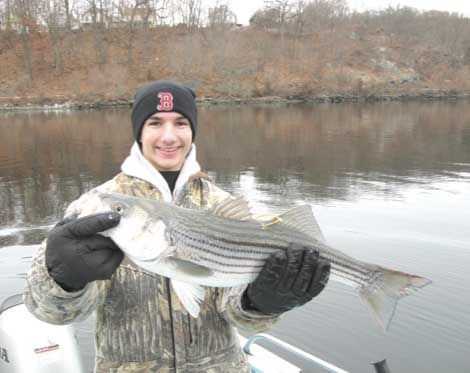
By Capt. Al Anderson:
Now that winter is approaching its end, and spring will have sprung within the next month, thoughts of fishing for local RI winter hold-over stripers have surely been on your mind, whether in the Providence and Seekonk Rivers, in Narrow River’s Pettasquamscutt Lakes or in Potter Pond, located in the western arm of Pt. Judith Pond. Each of these areas is accessible either on foot, or via a low profile skiff or kayak. But before you rush out and give it a try, when March air temps “soar” (into the 40’s—it’s all relative!) and winds are light, here are a few things you need to run through the over-winter striper equations. This concerns striper biology and how it can impact your success long before you ever make a cast or set out the first trolling gear of the new year.
Some Striper Biology
Juvenile striper biology is unlike that of adult fish in numerous ways. If you want to be successful, you have to realize those Hudson River-origin fish—only two and three years of age—have become torpid, a state that closely resembles hibernation, requiring only minimal energy expenditure. Since wintertime energy conservation by small fish is of utmost importance, they must take refuge in saltwater depths—as opposed to in the freshwater layer that meets the saltwater wedge in the middle to lower reaches of the water column to prevent excessive osmoregulation, the use of energy to maintain the salt content of their tissues.
They demonstrate schooling, but do not become active until saltwater temps rise above 40 degrees F. However, that doesn’t mean they won’t strike a lure in colder water; they will, and this is the reason the striped bass is classified as a “game fish.” About feed- ing: digestive enzymes fail to work at temps below 40F (another energy-saving mecha- nism). As waters warm above that mark thanks to solar radiation, lengthening daylight and climbing air temps, fish will invade freshwater to feed, balancing any previous energy expenditures with caloric intake in the form of baitfish. Because March weather can be cloudy and rainy, water temperatures will fluctuate considerably.
Over-Winter Striper Fallacies
Whichever area you fish for holdovers, better than 95% of the stripers you’ll catch are females; research has shown male stripers rarely migrate any distance from the Hudson. Research also indicates Hudson River-origin stripers conduct migration as early as the end of their second year (12 inches), with most contingents (schools of fish that repeat- edly over-winter in specific estuaries) in place their third year (16 inches). Historical records and archeological evidence suggest stripers were over-wintering in Rhode Island estuaries long before the first colonial settlers arrived, this behavior genetically passed on by previous generations that successfully did likewise. Sorry, it’s not due to the warm water outflows created by coal- or oil-powered electrical plants that attracted them to that location. Finally, hold-over stripers then move out to summertime foraging estuaries before returning the following fall.
Tackle and Techniques
Consider using heavy-duty freshwater spinning tackle for your O-W striper fishing. Sure, there will be that occasional fish in the teens or larger, with success dependent on properly tied line and lure connections. Most anglers today use spectra lines on their reels–Berkley’s Fireline, Suffix Performance Braid, or my favorite, Power-Pro, in pound- test ratings from 8 to 20 pounds. Forget using mono; but if you prefer a mono leader, use a uni- to uni- knot for braid to mono. My favorite casting lure is half-ounce bullet-shaped lead-head with a 4-inch Fin-S Fish tail in Alewife or Albino color.
For trolling, I use a Penn 320 Gti reel loaded with 50-pound-test braid, and paired up to an inexpensive 6 1⁄2-foot, medium-heavy action graphite stick (Bass Pro Shops offers a good one). Small 4-inch multi-hook trolling or casting plugs by RAPALA in either Mag- num or Husky-Jerk deep-diving models are my favorites.
For fly work, I use a 9-foot, 8-weight St. Croix rod coupled to a Cabella’s Prestige fly reel hosting a fast-sink 450-grain 9.0ips Rio striped bass fly line. If freshwater runs over the salt, you need to reach it—hence the fast-sink line, which may be either cast or trolled with good results. My favorite fly is a chartreuse Clouser on a #3 hook—attached to the fly line via a 6-foot section of 12-pound-test Seaguar fluorocarbon leader.
Further Advice
Keep your eyes peeled for the first signs of ice-out on protected bodies of freshwater ponds & lakes, as they’ll lag well behind the saltwater coves. Especially in the estuarine environments with tidal influences, it will be key to note the depth at which the saltwater meets the freshwater surface layer; as a rule, most of the active schoolies will patrol along the “ceiling” of the deeper saltwater layer. As a result, if you are running a small boat or fishing kayak, you’ll be glad if you have a fishfinder that will let you dial in the unit’s “gain” until the machine displays what I like to call the “halocline,” the vertical boundary between fresh and salt water. This can help you dial in the depth of trolled offerings, or help you determine proper sink time on cast offers. Vary retrieve speeds, and don’t be shy about ripping a lure through the water at a fair clip—winter-weary linesides aren’t shy about knocking off even fast-moving targets. Be sure you comply with license regula- tions and if planning on a trailered boat, see to it all safety requirements are in place. Last but not least, best time to go is on a sunny day with light SW wind at least three days following a heavy rain. Have fun and good luck.









